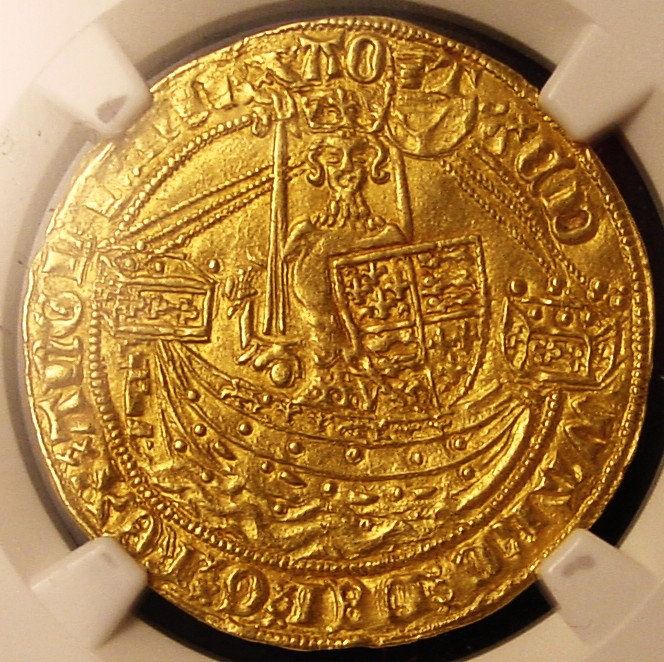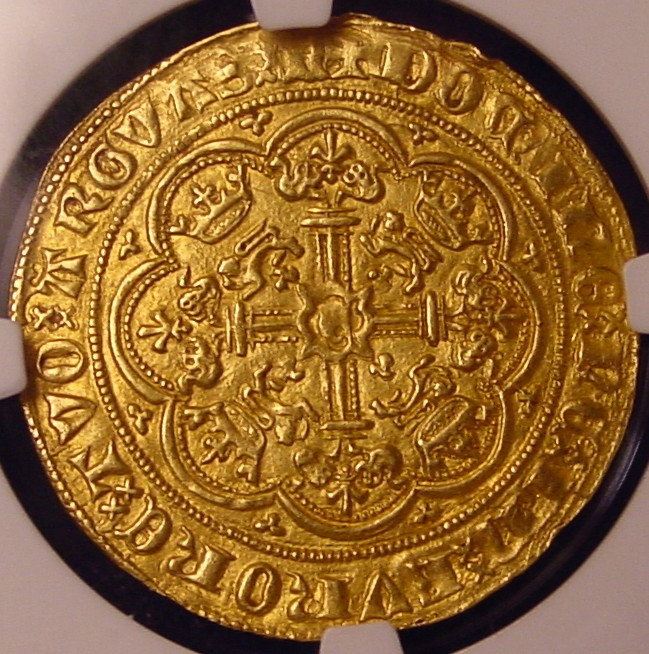British Kings "Bullet Book", Edward III, 1327 - 1377


Edward III Half Nobel
Edward III introduced gold coin coinage to the British system.
Edward III became king after his father was forced to abdicate. Since he was 14 years old at the time, the power was in the hands of his mother, Isabella of France and her lover, Mortimer, Earl of March who had led the coup against his father.
• When Edward became of age he asserted his birthright. He ultimately had Mortimer executed as a traitor and sent his mother into exile.
• Edward was a strong king who reasserted his claims to French territory. He defeated the French, with an outnumbered force, at Crecy and took Calais by siege.
• Edward’s son, also named Edward, was a great warrior. He was known as “The Black Prince” because of the color of his armor. He earned his reputation from his performance in battle during the French wars. The black prince died before he could take the throne.
• England and Europe were decimated by the Black Death. The plague killed a third of the British population.
• Middle English came to flower during Edward’s reign. Geoffrey Chaucer wrote The Canterbury Tales soon after Edward’s reign from 1387 to 1400.
• The expanding economic influence of the England prompted Edward III to issue the first British gold coins. The noble has a value of 6 shillings, 8 pence.
Comments
6 shillings, 8 pence. The British seem to have had a love of odd denominations. Did that value equal some tax or other common cost during that era?
The values and the sizes of the coins changed with the value of gold and silver at the time. As we shall see in a little less than century there would be a reduction in the size of the basic unit, the penny, and a new gold coin to keep the merchants happy that was due to that bullion value change.
The older coins got re-expressed, over time, into newer units/newer coins. One supposes that 80% of the people before 1750 never saw a gold coin, let alone handle one.
Also, the stability of the British gold and silver coinage 1815-1914 (or 1919 for the silver) sticks in our modern minds, it was so unusual.
Gold coins hadn't been made in western Europe for centuries until around 1250 when Florence introduced the florin.
Edward III's half nobles at 60 grains were near the size of the Florence florin trade coins at 54 grains.
His administration also tried to keep foreign gold coins out of England by setting up exchange stations in Dover.
The Mysterious Egyptian Magic Coin
Coins in Movies
Coins on Television
6 Shillings, 8 pence, is 80 pence. Since large denomination coins were still new, it made sense to initially value them in multiples of the more familiar penny. As others have mentioned, coins were revalued from time to time in order to respond to market forces. On the Continent, gold coins like the Florin were the stable coinage, while silver was frequently debased. England took a different path, maintaining the weight and fineness of the penny fairly consistently until Henry VIII discovered the power of debasement. But while the silver coinage remained stable, frequent revaluations and reforms of the gold coinage were needed to keep it from becoming more profitable to export than to use in commerce.